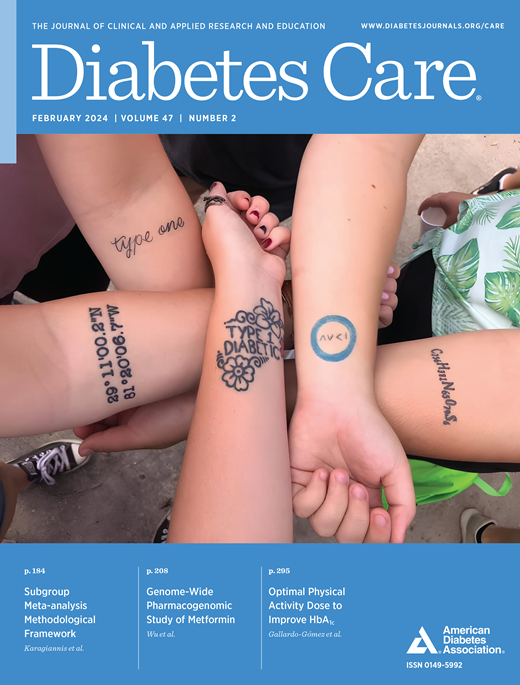Impaired Rest–Activity Rhythm Characteristics Predict Higher Risk of Incident Type 2 Diabetes in UK Biobank Participants
IF 16.6
1区 医学
Q1 ENDOCRINOLOGY & METABOLISM
引用次数: 0
Abstract
OBJECTIVE Circadian rhythms play a key role in metabolic health. Rest–activity rhythms, which are in part driven by circadian rhythms, may be associated with diabetes risk. There is a need for large prospective studies to comprehensively examine different rest–activity metrics to determine their relative strength in predicting risk of incident type 2 diabetes. RESEARCH DESIGN AND METHODS In actigraphy data from 83,887 UK Biobank participants, we applied both parametric and nonparametric algorithms to derive 13 different metrics characterizing different aspects of rest–activity rhythm. Diabetes cases were identified using both self-reported data and health records. We used Cox proportional hazards models to assess associations between rest–activity parameters and type 2 diabetes risk and random forest models to determine the relative importance of these parameters in risk prediction. RESULTS We found that multiple rest–activity characteristics were predictive of a higher risk of incident diabetes, including lower pseudo-F statistic (hazard ratio [HR] of quintile 1 ([Q1] vs. Q5 1.27; 95% CI 1.09–1.46; Ptrend < 0.001), lower amplitude (HRQ1 vs. Q5 2.56; 95% CI 2.21–2.97; Ptrend < 0.001), lower midline estimating statistic of rhythm (HRQ1 vs. Q5 2.59; 95% CI 2.24–3.00; Ptrend < 0.001), lower relative amplitude (HRQ1 vs. Q5 4.64; 95% CI 3.74–5.76; Ptrend < 0.001), lower M10 (HRQ1 vs. Q5 3.82; 95% CI 3.20–4.55; Ptrend < 0.001), higher L5 (HRQ5 vs. Q1 1.88; 95% CI 1.62–2.19; Ptrend < 0.001), and later L5 start time (HRQ5 vs. Q1 1.20; 95% CI 1.04–1.38; Ptrend = 0.004). Random forest models ranked most of the rest–activity metrics as top predictors of diabetes incidence, when compared with traditional diabetes risk factors. The findings were consistent across subgroups of age, sex, BMI, and shift work status. CONCLUSIONS Rest–activity rhythm characteristics measured from actigraphy data may serve as digital biomarkers for predicting type 2 diabetes risk.在英国生物银行参与者中,休息-活动节律特征受损预示着发生2型糖尿病的高风险
目的:昼夜节律在代谢健康中发挥关键作用。部分由昼夜节律驱动的休息-活动节律可能与糖尿病风险有关。有必要进行大规模的前瞻性研究,以全面检查不同的休息-活动指标,以确定它们在预测2型糖尿病发生风险方面的相对强度。研究设计和方法在83,887名英国生物银行参与者的活动记录数据中,我们应用参数和非参数算法推导出表征休息-活动节律不同方面的13种不同指标。通过自我报告数据和健康记录确定糖尿病病例。我们使用Cox比例风险模型来评估休息-活动参数与2型糖尿病风险之间的关系,并使用随机森林模型来确定这些参数在风险预测中的相对重要性。结果我们发现,多种休息-活动特征可预测较高的糖尿病发生风险,包括五分位数1 ([Q1] vs. Q5)的伪f统计量(风险比[HR])较低([Q1] vs. Q5 = 1.27;95% ci 1.09-1.46;Ptrend, lt;0.001),振幅较低(HRQ1 vs. Q5 2.56;95% ci 2.21-2.97;Ptrend, lt;0.001),心律中线下估计统计量(HRQ1 vs. Q5 2.59;95% ci 2.24-3.00;Ptrend, lt;0.001),相对振幅较低(HRQ1 vs. Q5 4.64;95% ci 3.74-5.76;Ptrend, lt;0.001), M10较低(HRQ1 vs. Q5 3.82;95% ci 3.20-4.55;Ptrend, lt;0.001), L5较高(HRQ5 vs Q1 1.88;95% ci 1.62-2.19;Ptrend, lt;0.001), L5开始时间较晚(HRQ5 vs. Q1 1.20;95% ci 1.04-1.38;p趋势= 0.004)。与传统的糖尿病风险因素相比,随机森林模型将大多数休息-活动指标列为糖尿病发病率的主要预测因素。这些发现在不同年龄、性别、BMI和轮班工作状态的亚组中是一致的。结论:从活动记录仪数据中测量的休息-活动节律特征可作为预测2型糖尿病风险的数字生物标志物。
本文章由计算机程序翻译,如有差异,请以英文原文为准。
求助全文
约1分钟内获得全文
求助全文
来源期刊

Diabetes Care
医学-内分泌学与代谢
CiteScore
27.80
自引率
4.90%
发文量
449
审稿时长
1 months
期刊介绍:
The journal's overarching mission can be captured by the simple word "Care," reflecting its commitment to enhancing patient well-being. Diabetes Care aims to support better patient care by addressing the comprehensive needs of healthcare professionals dedicated to managing diabetes.
Diabetes Care serves as a valuable resource for healthcare practitioners, aiming to advance knowledge, foster research, and improve diabetes management. The journal publishes original research across various categories, including Clinical Care, Education, Nutrition, Psychosocial Research, Epidemiology, Health Services Research, Emerging Treatments and Technologies, Pathophysiology, Complications, and Cardiovascular and Metabolic Risk. Additionally, Diabetes Care features ADA statements, consensus reports, review articles, letters to the editor, and health/medical news, appealing to a diverse audience of physicians, researchers, psychologists, educators, and other healthcare professionals.
 求助内容:
求助内容: 应助结果提醒方式:
应助结果提醒方式:


